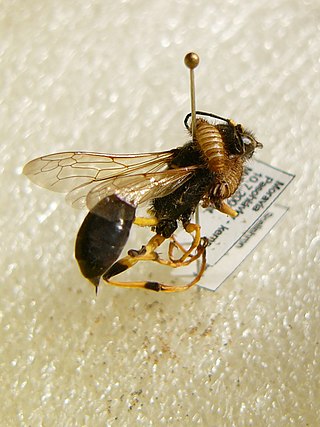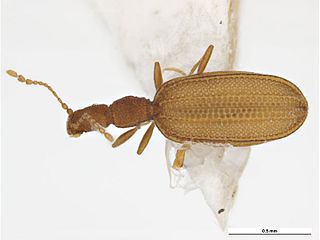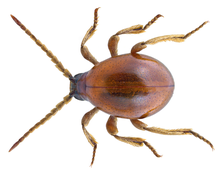
A pest is any organism harmful to humans or human concerns. The term is particularly used for creatures that damage crops, livestock, and forestry or cause a nuisance to people, especially in their homes. Humans have modified the environment for their own purposes and are intolerant of other creatures occupying the same space when their activities impact adversely on human objectives. Thus, an elephant is unobjectionable in its natural habitat but a pest when it tramples crops.

Bookworm is a general name for any insect that is said to bore through books.

Dermestidae are a family of Coleoptera that are commonly referred to as skin beetles. Other common names include larder beetle, hide or leather beetles, carpet beetles, and khapra beetles. There are over 1,800 species described.

The khapra beetle, also called cabinet beetle, which originated in South Asia, is one of the world's most destructive pests of grain products and seeds. It is considered one of the 100 worst invasive species in the world. Infestations are difficult to control because of the insect's ability to survive without food for long periods, its preference for dry conditions and low-moisture food, and its resistance to many insecticides. There is a federal quarantine restricting the importation of rice into the U.S. from countries with known infestations of the beetle. Khapra beetle infestation can spoil otherwise valuable trade goods and threaten significant economic losses if introduced to a new area. Handling or consuming contaminated grain and seed products can lead to health issues such as skin irritation and gastrointestinal distress.

Cleridae are a family of beetles of the superfamily Cleroidea. They are commonly known as checkered beetles. The family Cleridae has a worldwide distribution, and a variety of habitats and feeding preferences.

Latridiidae is a family of tiny, little-known beetles commonly called minute brown scavenger beetles or fungus beetles. The number of described species currently stands at around 1050 in 29 genera but the number of species is undoubtedly much higher than this and increases each time a new estimate is made.
Miss Spider's Sunny Patch Kids is a 2003 Canadian computer-animated television special produced by Nelvana. It serves as the pilot for the show Miss Spider's Sunny Patch Friends. It aired on Treehouse TV in Canada on March 31, 2003. The special was based on David Kirk's book series of the same name, as well as the Sunny Patch brand of toys that Kirk designed. The special features well-known celebrity voices including US actress Brooke Shields as the voice of Miss Spider, Rick Moranis as the voice of Holley, and Tony Jay as the voice of Spiderus Reeves.

Oryzaephilus surinamensis, the sawtoothed grain beetle, is a beetle in the superfamily Cucujoidea. It is a common, worldwide pest of grain and grain products as well as chocolate, drugs, and tobacco. The species' binomial name, meaning "rice-lover from Suriname," was coined by Carl Linnaeus, who received specimens of the beetle from Surinam. It is also known as the malt beetle and may be referenced in the poem This Is The House That Jack Built in the line "....the rat that ate the malt that lay in the house that Jack built" the malt referenced may not be actual malted grain but a sawtoothed grain beetle.

Spider beetles make up the subfamily Ptininae, in the family Ptinidae. There are approximately 70 genera and 600 species in the subfamily, with about 12 genera and 70 species in North America north of Mexico.

Ptinidae is a family of beetles in the superfamily Bostrichoidea. There are at least 220 genera and 2,200 described species in Ptinidae worldwide. The family includes spider beetles and deathwatch beetles.
Home-stored product entomology is the study of insects which infest foodstuffs stored in the home. It deals with the prevention, detection and eradication of the pests.

Mezium americanum, the American spider beetle or black spider beetle, is a species of beetle in the subfamily Ptininae, the spider beetles. These are sometimes mistaken for spiders or mites because of their rounded abdomens and long legs. It has a cosmopolitan distribution, but it is an exotic species in Australia.

Pseudeurostus hilleri, the Japanese spider beetle, is a species of spider beetle in the family Ptinidae.

Ptinus fur, the white marked spider beetle, is a species of spider beetle in the genus Ptinus, with a nearly cosmopolitan distribution.

Gibbium is a genus of beetles in the family Ptinidae.

Ptinus is a genus of beetles distributed throughout much of the world, including Africa, the Australian region, the Palearctic, the Near East, the Nearctic, and the Neotropical realm. It is a member of the subfamily Ptininae, the spider beetles.

Anthrenocerus australis is a species of beetle belonging to the Dermestidae family. It is commonly known as the Australian carpet beetle and is one of the most researched of the thirty-one species in the Anthrenocerus genus. This is generally attributed to its prevalence throughout Australia and New Zealand and the negative economic and agricultural impact it has as a pest. It is the larvae that causes damage to products, not the adult beetle. The total life cycle of this insect is around three years, most of which is spent as a larva. Once the beetle reaches maturity, it only lives for between two and six weeks.

Adistemia watsoni is a species of minute brown scavenger beetles native to Europe.

Gibbium aequinoctiale, the smooth spider beetle, is a species of spider beetle in the family Ptinidae. It is found in the Caribbean, Europe and Northern Asia, Central America, North America, and South America. It has been reported from many parts of the world as Gibbium psylloides.

Dienerella filum, the common plaster beetle, is a species of fungus beetle in the family Latridiidae. It is found in damp conditions in buildings throughout the world, feeding on mould growing on the walls, and on poorly-stored products.


















